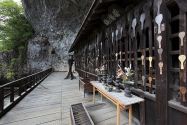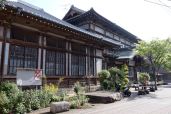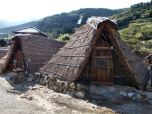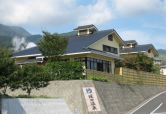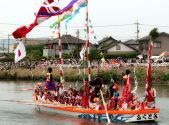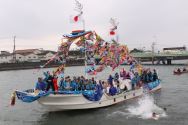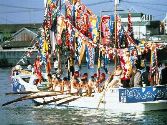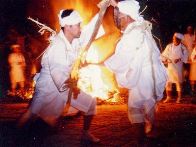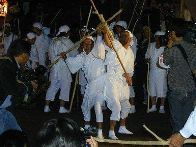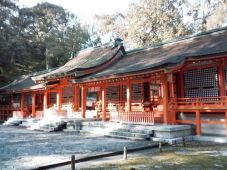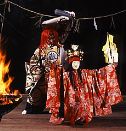History of Oita
Oita was historically known as Funai, which is the capital of Bungo. In 6th century BC, Kyushu was divided into four regions , including Tsukushi-no-kuni, Hi-no-kuni, Kumaso-no-kuni and Toyo-no-kuni. Oita was a part of Toyo-no-kuni (Abundunt Land). The origin of the name"Oita" could be traced back to the 8th century . According to the document "Chornicles of Bungo", Empress Keiko visited Toyo-no-kuni, she remarked"This is indeed a vast land. It shall be shown as Okita-kuni" , and later "Okita-kuni" was written as"Oita". After the Meji Restoration, Bungo and Buzen provinces were combined to form the Oita.
Nowadays, Oita is famous for its hot springs, perticulary in the city of Beppu, as there are 5053 hot springs located in the Oita prefecture, ranked #1 in Japan.
Usuki Stone Buddha 臼杵磨崖仏
There are over 60 statues carved on natural stone , and teh Usuki Stone Buddha stand at Usuki City, Oita. Each Buddha statues is different and unique while visitors remarked that looking at their faces allows you to feel calm and peaceful. The "National Treature-Usuki Stone Buddha Statue Fire Festival" is held in this prefecture, during the festival citizens and visitors will light 1000 torch fires at night.
Address: 〒875-0064 804-1, Fukata, Usuki-shi, Oita
Access information: 35 minute train ride from Oita station to Usuki Station/ 5 minute car ride from Usuki IC
Opening hours: 6:00 am - 7:00 pm (April to September)
6:00 am-6:00 pm(October to March)
Fees: Adults(High school students and above): 530 yen
Children(up to middle school student): 260 yen
Link to homepage: http://sekibutsu.com/index.php
More information:http://www.oishiimati-oita.jp/english/index.html
Rakanji temple 羅漢寺
Rakanji temple is built on the middle cliff of Mr. Rakan. It was built in 1337 but destroyed by fire in 1943, the main hall was then reconstructed in 1969. The main gate and the main hall is stands directlyon the rocky cliff. Over 3700 Buddhas are enshrined. It is a tradition at Rakanji temple for visitors to write wishes on rice paddles and hang them up, this way their wishes might come true.
Access information: 1.5 hour by bus from Oita Airport to Nakatsu Station.
Thirty-minutes by bus from Nakatsu Station to Ao-no-domon, change at Kakisaka, 50 minutes from there to Shin-yabakei.
Opening hours: 9:00 am - 17:00pm everyday
Fees: 300 yen for entrance
Link to homepage: http://www.rakanji.com/index.html
Beppu Hatto 別府八湯
"Hatto" suggests that there are 8 public hot springs located in Beppu city in which some of them have a long history tracing back to the beginning of the 8th century. The Beppu Hatto are: Hamawaki hot spring, Beppu hot spring, Kamegawa hot spring, Kannawa hot spring, Kankaiji hot spring, Horita hot spring, Shibaseki hot spring and Myoban hot spring.
Opening hours and fees :
Beppu hot spring: 6:30-22:00 Entrance: 500 yen
Kamegawa hot spring: 8:30-5:00 Entrance:1000 yen
Oita's culture, Bungotakada Horan Enya
Festivals and Traditional events are held in Oita's shrines and temples annually that serves for different purposes. Usually during New Year times, many citizens and fishermans would pray for safety on sea and a bumper catch of fish . The festival is called the Bungotakada’s Horan Enya. The Bungatakada's Horan Enya is also known as the Fisherman's festival. On this day, fisherman would ride on colorful boats decorated for the festival and sail out into the waves. They will sail through Lake Shinjiko, Ohashigawa Bridge, and Nakaumi with other various ships.
Kebesu Festival ケベス祭
Kebesu Festival is a fire festival held Kunisaki City, Oita annually on October 14. On the festival night, the “Kebesu,” who is wearing a grotesque mask, walks around the precinct, hitting the stick called Samasuta with a fan and dashes toward the holy bonfire. Some men called Toba who are in white costume try to guard the fire while they fight with Kebesu for fire. It is said that if the sparks fall on you, you will be good in health throughout the year.
Nakatsu City 中津市
Nakatsu City, located on the Northern boarder of the Oita Prefecture. Nakatsu is a castle town, while vistors are able to visit the residence of the well known Okudaira Clan of Nakatsu, Fukuzawa Yukichi- founder of Keio University. Nakatsu City has the third largest population in the Oita prefecture, while Oita city and Beppu city rank 1st and 2nd respectively.
Nakatsu castle 中津じょう
The Nakatsu castle was built in 1588 under the orders of Lord Kuroda . Stone walls and moats remain in the same place they were. The water level changes as sea water enters and leaves. It is chosen as one of the three major water castles in Japan.
Nakatsu Castle- Fees: Adults- 400 yen , High School-200 yen, Middle school-150 yen, Elementry- 100 yen
Access information:
From JR Hakata Station - Nakatsu Station 6 min(250 yen) + a 15 minute walk
Nakatsu Castle homepage: http://www.nakatsujyo.jp/
Usa Jingu 宇佐神宮
Usa-jingu was the first of many shrines dedicated to Emperor Ojin, who is the god of military power.
Address: 2859 Minami-Usa, Usa-shi, Oita
Opening hours: 5:30-21:00 (April to September)
6:00-21:00(October to March)
Access information: JR Usa Stn by bus 15-min. Usa-Hachiman Stop, 15-min by walk
Link to homepage:http://www.usajinguu.com/
Kagura (神楽)
Kagura is a type of traditional Japanese dance that is to worship the gods using props , flutes and drums. Ondake-ryu kagura, a type of Kagura in Oita has around 560 years of history, and is based on Japanese mythology. Kagura dancers are trained strictly in Japan, and starting in 1993, children are also involved in learning the Kagura dance.



